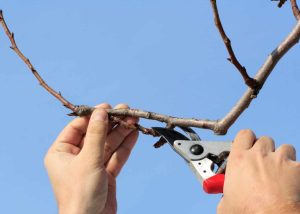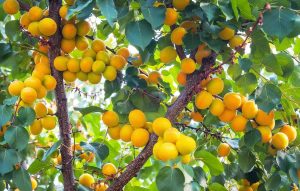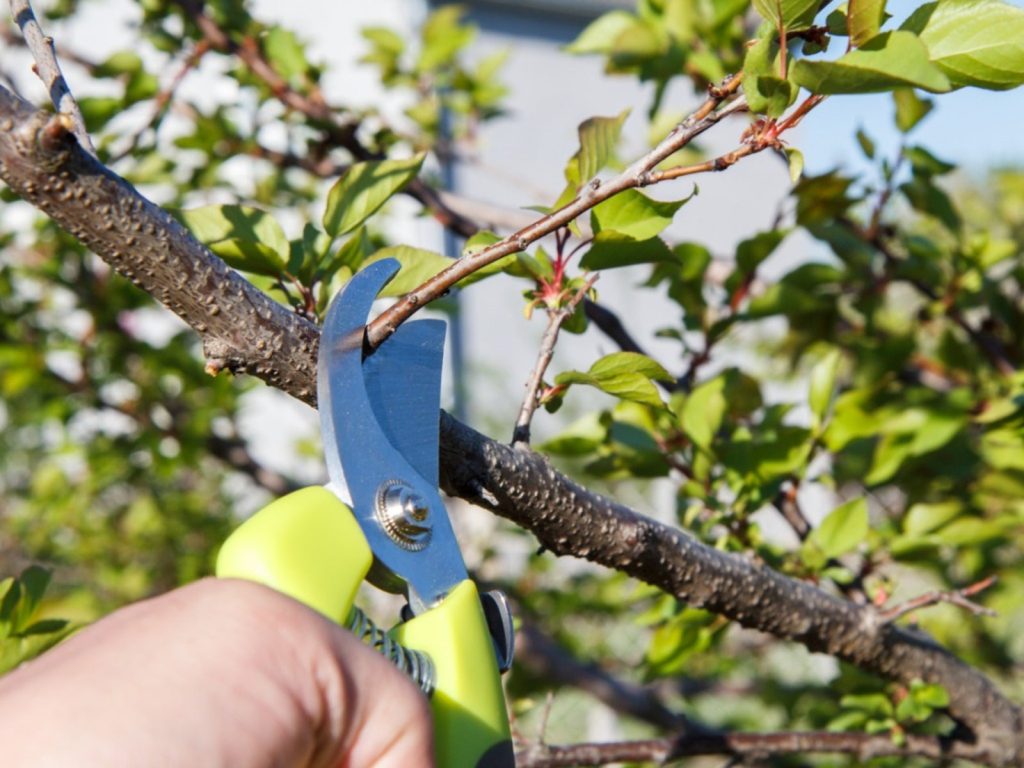How to Trim Apricot Trees?
Apricot trees are not only attractive additions to your environment, but they also produce wonderful fruit. However, careful pruning is required to keep them healthy and productive. In this article, we’ll walk you through how to trim an apricot tree. Whether you’re a beginner gardener or a professional arborist, Site Crosbyarborist can help you learn the art of apricot tree care.
Anatomy of apricot
An apricot tree has roots, a trunk, branches, leaves, blossoms, and fruit. Roots support the tree and absorb water and minerals from the earth. The trunk provides structural support and delivers water and nutrients to the branches. Branches grow from the trunk, carrying leaves and flowers. Photosynthesis, or the conversion of sunlight into energy, is carried out by leaves. Flowers blossom in the spring and attract pollinators such as bees. After pollination, they develop into apricot fruits that mature in July. Apricots have smooth, velvety skin that covers tasty flesh and a firm seed. This fruit-bearing tree thrives in temperate settings with well-drained soil and ample sunlight.

Growth Habits and Patterns
Plant growth habits and patterns vary greatly depending on the species and environmental factors. Some plants have determinate growth, reaching a definite size, whilst others have indeterminate growth, continuing to develop throughout their lives. Apical dominance, in which the main stem prevents lateral branch growth, and sympodial growth, in which branching occurs from the main stem, are two types of growth patterns. Plants may also have seasonal growth, with periods of active development followed by dormancy. Light, water, nutrients, and temperature all influence development rates and patterns. Understanding these routines helps with cultivation, resulting in maximum plant health and productivity.
Benefits of trimming the apricot tree
Trimming apricot trees promotes the establishment of new shoots and branches, which can lead to more fruit output.
Improves Air Circulation: Regular pruning promotes air circulation throughout the tree canopy, lowering the risk of fungal infections and enhancing overall tree health.
Control tree size: Trimming helps you control the size of your apricot tree, making it easier to gather fruit and keep it in the appropriate form.
Remove diseased and dead wood: Trimming helps to locate and remove diseased or dead branches, reducing infection spread and enhancing the tree’s health.
Stimulates growth: Proper pruning promotes the growth of lateral branches and the formation of strong, healthy shoots.
Increases sunshine Exposure: By removing extra branches, more sunshine may reach the core regions of the tree, enabling greater fruit ripening and overall tree health.
When you should trim an apricot tree?
Trimming an apricot tree is best done during its dormant season, which lasts from late winter to early spring before the buds swell. This time permits the pruning wounds to heal optimally while also reducing disease transmission risk. Avoid trimming during active growth, flowering, or fruit set, as this might stress the tree and diminish fruit output. Furthermore, it is best to avoid trimming during periods of excessive cold or rainy weather, as this can stress the tree and increase the chance of harm.
Tools and equipment required to trim an apricot tree
To properly trim an apricot tree, you will need the following tools and equipment:
Pruning Shears: Sharp pruning shears are required for precisely cutting small branches and twigs.
Loppers: Loppers are larger than pruning shears and are used to remove thicker branches that shears cannot reach.
Pruning saws are good for cutting bigger branches and removing dead timber.
Safety Equipment: Wear gloves to protect your hands and goggles to protect your eyes from debris.
Ladder: Depending on the height of the tree, you may need a ladder to safely access higher branches.
Disinfectant: To avoid the spread of illnesses, disinfect your pruning equipment between cuts, especially while working with sick branches.
Garden tape or sealant: After making cuts, wrap bigger wounds with garden tape or sealer to promote healing.
Bucket or Tarp: Use a bucket or tarp to collect clipped branches and trash for quick cleanup.
Safety gears: Wear durable, closed-toe shoes with adequate traction to avoid slipping while working on the tree.
Pruning Guidebook: A pruning guidebook or internet resources will help you with optimal pruning techniques and timing for apricot trees.
How to trim an apricot tree?
Certainly! How to Trim Young, Established, and Potted Apricot Trees:
Young Apricot Trees
Initial Pruning: During the first year following planting, work on structuring the tree’s structure by eliminating any broken or crossing branches. Aim for an open centre to improve air circulation and sunshine penetration.
Selective Trimming: In the second and third years, shape the tree by eliminating any robust vertical shoots (suckers) and thinning out congested regions. Prune to promote outward growth and branch formation.

Height Control: If the tree is becoming too tall, deliberately cut the central leader to control height and encourage lateral branching. This helps to build a solid foundation for future fruit production.
Established Apricot Tree
Annual Maintenance: Every year, during the dormant season, evaluate the tree’s structure and health. Remove any dead, diseased, or damaged branches by pruning them back to the nearest healthy growth point or trunk.
Thinning out congested branches will increase air circulation and sunshine penetration within the canopy. Remove inward-growing or crossing branches to keep the centre open and prevent disease risk.
Renewal Pruning: For older trees, consider renewal pruning to revive them and encourage new growth. Each year, remove one or two of the oldest, unproductive branches and prune them back to a lateral branch or trunk.
Potted Apricot Trees
Container Size: Select a container that is large enough to hold the apricot tree’s root system and allow for proper growth. Choose a well-draining potting mix to avoid waterlogging.
Regular Pruning: Because of the limited space, prune potted apricot trees regularly to keep them manageable and increase fruit output. Remove any dead or diseased branches, and thin down congested growth.
Root Pruning: Every few years, carefully remove the tree from its container and trim the roots to keep them from becoming root-bound. Repot the tree in fresh soil to encourage healthy growth and yield.
Common mistakes to avoid
When trimming apricot trees, avoid the following common mistakes:
Excessive pruning can damage the tree and diminish fruit yield. Only remove branches that are essential to the tree’s health and structure.
Pruning at the Wrong Time: Pruning during active growth or flowering can cause stress to the tree and reduce fruit output. Stick to trimming during the dormant season to reduce stress and encourage healing.
Inappropriate Technique: Using dull or inappropriate pruning tools can result in jagged cuts that are difficult to heal and more prone to infection. Always use sharp, clean tools to make smooth, angled cuts directly above a bud or lateral branch.
Ignoring infected Branches: Failure to remove infected branches can cause infections to spread throughout the tree, compromising overall health and fruit quality. To avoid further harm, trim any diseased areas as soon as possible.
Removing Too Many Branches: Removing too many branches at once might shock the tree and limit its ability to recover. Selective pruning involves eliminating only the required branches to maintain balance and structure.
Ignoring Tree Size: Failure to consider the mature size of the apricot tree can lead to overcrowding and low fruit yield. Plan and place branches adequately to enable adequate ventilation and sunlight penetration.
Skipping Disinfection: Failure to disinfect pruning equipment between cuttings might spread infections from one branch to the next. To avoid contamination, always disinfect instruments with bleach or rubbing alcohol.
Neglecting Cleanup: Leaving clipped branches and waste at the tree’s base might attract pests and harbour diseases. Remove any pruned material from the area and properly dispose of it to keep the environment clean and healthy.
Avoiding these frequent blunders can keep your apricot tree healthy, productive, and well-maintained.
Related Posts:
Aftercare and Maintenance Tips
After cutting your apricot tree, use these aftercare and maintenance tips to encourage healthy growth and fruit production:
Watering: Give recently cut trees enough water, especially during dry spells, to promote healing and new growth. Check soil moisture levels and water deeply as needed.
Fertilisation: In early spring, use a balanced fertiliser to supply the nutrients needed for good foliage and fruit development. Application rates should be calculated according to the manufacturer’s instructions.
Mulching: Apply a layer of organic mulch around the tree’s base to conserve soil moisture, discourage weeds, and regulate soil temperature. To prevent rot, keep the mulch several inches away from the tree trunk.
Regularly examine the tree for pests, illnesses, or nutrient deficits. To avoid further damage, rectify any issues immediately.
Support: Provide support for heavily laden branches or immature trees to prevent them from breaking due to the weight of fruit or bad weather.
Pruning Maintenance: Continue to monitor the tree’s growth and prune as needed to maintain structure, eliminate dead wood, and promote fruit production.
Implementing these aftercare and maintenance measures will assist ensure your apricot tree’s continuing health and productivity.
FAQS
How much pruning should I do on my apricot tree?
To reduce stress and promote healthy growth, do not remove more than 20-30% of the tree’s canopy in a single pruning session.
May I prune my apricot tree throughout the summer?
Pruning apricot trees during the summer is generally not suggested, as it might stress the tree and interfere with fruit production.
How can I determine which branches I should prune?
Begin by eliminating dead, diseased, or damaged branches, followed by crossing or overloaded branches. Aim to keep the centre open and the canopy balanced.
What instruments are required to cut my apricot tree?
Pruning shears, loppers, a pruning saw for thicker branches, safety equipment like gloves and goggles, and disinfectant are all necessary to avoid disease spread.
Conclusion
Trimming an apricot tree is crucial for preserving its health, productivity, and appearance. Pruning during the dormant season and using the right procedures will help improve fruit output, avoid disease, and shape the tree to your requirements. Avoid typical blunders like overpruning and failing to provide aftercare, and keep an eye out for pests or illnesses regularly. Crosby Arborist can help you with apricot tree trimming and other arboricultural services. Contact us today.




